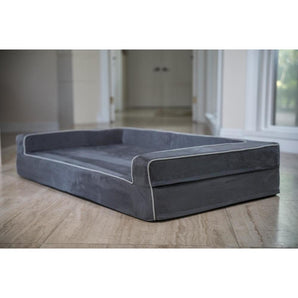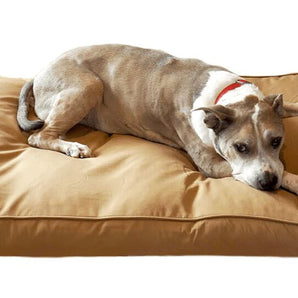When the temperature falls and the wind chill starts to bite, we humans bundle up in coats, boots, and gloves—but what about our dogs? Pet parents often wonder: How cold is too cold for dogs to be outside?
While many dogs enjoy a brisk winter walk, extreme cold can be dangerous, especially for small dogs, senior dogs, or breeds with thin coats. We'll give you all the info you need to assess your dog’s cold tolerance and keep them safe and warm during winter weather.
When is it Too Cold for a Dog to Be Outside?

As a general rule, when temperatures dip below 45°F (7°C), pet parents should start paying attention—especially if there’s wind, rain, or snow. Below 32°F (0°C), small dogs, thin dogs, senior dogs, and puppies can struggle to regulate body temperature. And once temperatures drop below 20°F (-6°C), even large dogs with thick coats can be at risk for hypothermia and frostbite.
Wind chill can make it feel colder than the actual temperature, which can increase heat loss from your dog’s body. Wet conditions, like sleet or snow, further reduce your dog’s ability to stay warm, especially if their coat gets soaked. If you wouldn’t be comfortable outside in the same conditions without multiple layers, it’s probably too cold for a dog walk.
What Factors Affect a Dog's Tolerance to Cold Temperatures?

Not all dogs handle cold weather the same way. Some are built for it, and others—not so much. Things like breed, size, and health all play a role in how your pup feels when the temperature drops, so what's tolerable for one dog may not be for another.
Breed and Coat Type
A dog’s coat plays a major role in how well they tolerate cold weather. Breeds with thick, double coats—like Huskies, Malamutes, and Newfoundlands—are naturally better equipped to stay warm in freezing temperatures. Their fur insulates their body, helping them retain heat and regulate body temperature even in snow and wind.
On the other hand, breeds with thin coats like or short hair Greyhounds, Chihuahuas, Boxers, and Dobermans struggle to stay warm in cold weather. These dogs lack the natural insulation of their fluffier counterparts and often benefit from wearing a winter coat or sweater on cold days.
Dog Breeds That Do Well in Cold Weather
Some breeds were practically built for extreme cold. These dogs typically have thick fur, a stocky build, and a history of thriving in winter climates. Breeds that tolerate cold well include:
-
Siberian Huskies
-
Alaskan Malamutes
-
Bernese Mountain Dogs
-
Saint Bernards
-
Akitas
-
Tibetan Mastiffs
-
Great Pyrenees
Even so, these dogs can still be at risk in extremely cold temperatures, especially if they’re not used to it or if they get wet.
Size and Body Fat
Size matters when it comes to staying warm. Small dogs lose heat more quickly than large dogs. That’s why tiny pups like Yorkies and Dachshunds often shake in winter weather even when wearing a coat.
Body fat also plays a role. Thin dogs tend to feel the cold more because fat acts as insulation. If your dog is on the leaner side, they may need extra help staying warm, even if they’re a breed that usually handles the cold well.
Health Issues
Certain health conditions can make it harder for dogs to tolerate cold temperatures. Older dogs, dogs with arthritis, and those with endocrine disorders like hypothyroidism may struggle to regulate body temperature. Cold weather can also make joint pain worse, especially during a winter walk.
If your dog has mobility issues, a weakened immune system, or is recovering from illness or surgery, it’s best to limit their time outside when the temps are low. Always check with your vet if you’re unsure about your dog’s cold tolerance.
How to Tell If It's Too Cold For Your Dog

Not sure if it’s too cold to walk your dog? Your dog’s behavior can offer helpful clues. Watch for signs like:
-
Shivering or trembling
-
Holding up their paws or limping
-
Whining, pacing, or trying to head back inside
-
Curling up and refusing to move
-
Cold ears, tail, or feet
-
Slowing down or appearing lethargic
If your dog’s paws are ice-cold, they’re shaking uncontrollably, or they just don’t seem like themselves after coming in from the cold, it’s better to be safe and give your vet a call. Frostbite on dog paws or ears might not show up immediately—it can take hours or even days for tissue damage to become obvious. And with hypothermia, waiting too long can be dangerous.
What to do right away: Bring your dog inside, wrap them in a warm (but not hot) blanket or towel, and call your vet for advice. Avoid using heating pads or hot water bottles, as extreme heat can actually make things worse. If your dog is wet, dry them gently with a towel and keep them warm while you wait for professional guidance.
Cold weather can be tough on our furry friends, especially if they’ve been out longer than expected. Keeping a close eye on your dog’s behavior and body temperature during winter walks helps prevent serious issues before they start. And when in doubt, always check with your vet.
Tips For Keeping Your Dog Warm

When it’s cold out, a little planning goes a long way in keeping your furry friend safe. Here are a few ways to help your dog stay warm:
-
Use a winter coat or sweater for dogs with thin coats, small dogs, or senior dogs. Make sure it covers their belly and chest for maximum warmth.
-
Protect their paw pads with dog booties or paw balm to guard against ice, salt, and freezing temperatures.
-
Keep your walks short during extremely cold weather. Multiple short outings are better than one long winter walk.
-
Avoid wet conditions when possible, and dry your dog thoroughly if they get wet. A soggy dog’s coat loses its insulating power.
-
Provide a warm place to sleep indoors. Use an orthopedic dog bed to elevate your dog off cold floors and help them retain body heat. These chew-resistant, memory foam beds are especially great for large dogs, senior dogs, and dogs with joint pain.
-
If your dog sleeps in a crate, add a chew-resistant, insulated crate pad for extra warmth. Keep the crate away from drafty windows or unheated areas.
Activities For When It's Too Cold To Walk Your Dog Outside
When freezing temperatures or icy weather conditions make outdoor walks unsafe, there are still ways to help your dog burn off some of that excess energy:
-
Indoor games like tug, hide-and-seek, or fetch down a hallway can help burn off energy.
-
Puzzle toys or treat-dispensing toys give your dog mental stimulation and keep boredom at bay.
-
Training sessions are a great way to reinforce good behavior and build your bond indoors.
-
Set up an indoor obstacle course with couch cushions or chairs for your dog to climb, crawl under, or weave through.
Even on days when you can’t walk your dog, try to give them physical and mental challenges. Most dogs—even adult dogs—thrive on routine, so keeping some kind of daily activity will help.
Keep Your Dog Happy and Healthy All Winter Long

Cold weather doesn’t have to mean cabin fever. With a little preparation and the right gear, you and your dog can enjoy winter safely. Just remember to pay attention to your dog’s signals, limit exposure during extremely cold temperatures, and provide a warm, comfortable space indoors.
At Bully Beds, we know how important comfort is—especially during winter. That’s why our non-chewable orthopedic dog beds are made to support your pup’s joints and help them stay warm off cold floors. Because a happy, healthy dog starts with good sleep—no matter the weather outside.





